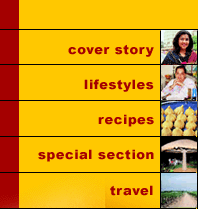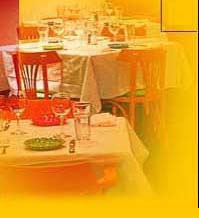


|
|
|
�WELCOME aboard the INS Kursura, it is the first submarine museum in Asia,� says K. V. Chelapathi Rao, a dark and handsome Andhraite with flashing white teeth. He was, at some time in its 31-year service with the Indian Navy, the INS Kursura�s communication officer. Now he acts as a guide on the submarine museum, taking visitors on board and along the 91-metre-long underwater behemoth, giving them a peep into the life of a submariner. The submarine stands enormously and magnificently on the beach, between the sea and R. K. Road, a football field in length and rising majestically up several storeys high. You can see it from miles away, it is that big and impressive, like some beached monster from the deep. It took some enterprise to haul the 2,469 tonne submarine out of the Bay of Bengal once it had been decommissioned by the Navy in February 2001, and install her as a museum on the R. K. Beach Road. And responsible for this project is the Eastern Naval Command itself, stationed in Vizag, with the Visakhapatnam Urban Development Authority (VUDA).
Outside the INS Kursura, the R. K. Beach Road is a five-kilometre curving stretch of asphalt running alongside blue waters and golden sands. There is another war memorial opposite the old submarine, to commemorate the 1971 war in which the INS Kursura also participated, and it is in a garden in which an old warplane and several missiles are placed at strategic positions.
A dense, high-rise residential development faces the sea on R. K. Beach Road with landscaped gardens and small parks. The VUDA has been careful to treat the environment kindly. The pavements on both sides of the road, the retaining wall and grill on the sides of the parks, are all designed to give a harmonious landscape. Statues of eminent persons are placed in the parks and they form the linking element of all the parks. Fountains and sculpture add to their attraction. Pathways address the need of the health conscious. There is lighting on high masts, bollards and even at the seats, and when lit up, R. K. Beach Road becomes a user-friendly and enjoyable place at night.
Both, the buggy and bus, are always parked on the beach road. Or walk around yourself, as you might on Bombay�s Marine Drive and Worli Seaface, taking the evening air and the sights and sounds of Vizag coming out to grab what must be the best part of the city�s night-life. On the beach, swimming and water sports are banned because of the jagged rocks beneath the water�s surface. But there are plenty of other attractions. Like merry-go-rounds and tiny tumbling-boxes. And a number of food carts and stalls, with vendors selling everything from corn-on-cob to sizzling omelettes made with stuffings of cheese and mushroom.
The more fashionable people who step out to R. K. Beach on Sunday evenings, which includes the Eastern Naval Command�s families who live nearby, make a night of it by ending up dining at one of Vizag�s five-star hotels. Fortunately, all of them are located at the start and end of the road. There is the Park Hotel at the southern tip of the road and the Taj Residency and ITC�s Grand Bay at the northern starting point of road. All these hotels have speciality multi-cuisine restaurants that offer great food. The ideal thing to do would be to begin your visit to R. K. Beach Road by first stopping at the old Kali Temple there, then whetting your appetite by walking the five-kilometre stretch up and down, before going in for dinner. The activity shuts down by 9, because that is the time the last bus from R. K. Beach Road leaves for the city. Everybody goes home and the lights on the INS Kursura are switched off for the night, giving the submarine a sinister appearance.
|

Home Page
About the mag
Subscribe
Advertise
Contact Us

 Submarine Boulevard!
Submarine Boulevard!
 One-and-half years after it had surfaced in Vizag, the authorities opened the INS Kursura as a submarine museum to the public on August 9, 2002. Since then, it has been drawing in crowds between 4 and 8 p.m. on weekdays and from 8 a.m. to 8 p.m. on Saturdays, Sundays and public holidays. Guided tours are taken on board by Telugu and Hindi speaking submariners like K. V. Chelapathi Rao. Buy yourself a ticket for Rs. 10. If you are taking a camera on board, there is an additional charge of Rs. 20. And spend another Rs. 10 for a small, colourful brochure on the INS Kursura. This will all be money well spent. But please, please don�t leave Vizag without visiting the submarine.
One-and-half years after it had surfaced in Vizag, the authorities opened the INS Kursura as a submarine museum to the public on August 9, 2002. Since then, it has been drawing in crowds between 4 and 8 p.m. on weekdays and from 8 a.m. to 8 p.m. on Saturdays, Sundays and public holidays. Guided tours are taken on board by Telugu and Hindi speaking submariners like K. V. Chelapathi Rao. Buy yourself a ticket for Rs. 10. If you are taking a camera on board, there is an additional charge of Rs. 20. And spend another Rs. 10 for a small, colourful brochure on the INS Kursura. This will all be money well spent. But please, please don�t leave Vizag without visiting the submarine. The road itself and the beach get their name from the picturesque Rama Krishna Mission there around which the rest of civilisation came up in the area. It is a lovely mission on a sloping road, a little cut off from the rest of the activity on the beach, but which still attracts a number of people because of the nature of social service it performs. Of particular fascination is the central hall of the mission in which, it is said, anybody sitting there can meditate freely and easily. People come from far and wide to do this.
The road itself and the beach get their name from the picturesque Rama Krishna Mission there around which the rest of civilisation came up in the area. It is a lovely mission on a sloping road, a little cut off from the rest of the activity on the beach, but which still attracts a number of people because of the nature of social service it performs. Of particular fascination is the central hall of the mission in which, it is said, anybody sitting there can meditate freely and easily. People come from far and wide to do this. If you are a visitor to the city and visiting R. K. Beach Road for the first time, look out for the horse buggy that comfortably seats ten and hire it to take you around. Or the small Andhra Pradesh Tourism�s open-top, double-decker bus that does a tour of the coast and nearby hilly areas in the evening.
If you are a visitor to the city and visiting R. K. Beach Road for the first time, look out for the horse buggy that comfortably seats ten and hire it to take you around. Or the small Andhra Pradesh Tourism�s open-top, double-decker bus that does a tour of the coast and nearby hilly areas in the evening.  The most popular eat is a small puri-like savoury in which chopped green mango, onion, tomato and cucumber are filled and which is spiked with tamarind water. There is also pav-bhaji, the Bombay variety, which is quite a fascination for the simple Vizag Andhraite.
The most popular eat is a small puri-like savoury in which chopped green mango, onion, tomato and cucumber are filled and which is spiked with tamarind water. There is also pav-bhaji, the Bombay variety, which is quite a fascination for the simple Vizag Andhraite.